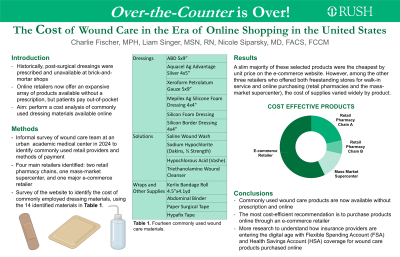Health Economics
(HE-003 (RPT-009)) Over-the-counter Is Over! the Cost of Wound Care for Patients in the Era of Online Shopping in the United States
Friday, May 2, 2025
4:45 PM - 5:45 PM East Coast USA Time

Liam Singer, MSN, RN – Department of Surgery – Rush University Medical Center; Nicole Siparsky, MD, FACS, FCCM – Chief, Acute Care Surgery and Surgical Critical Care Services; Surgical Director, AICU; Vice Chair of Academic Affairs, Department of Surgery, Rush University Medical Center
Introduction: In the past, surgeons prescribed dressings required for healing. These supplies were expensive and unavailable at common brick-and-mortar shops. The out-of-pocket cost of supplies fell to the patient, regardless of insurance status. Today, online retailers offer an expansive array of products without prescription. Providers may be unfamiliar with online options and evolving insurance coverage. The purpose of this investigation is to perform a cost analysis of commonly used dressing materials that are available online.
Methods: We surveyed the wound care team informally at an academic medical center in 2024 to identify commonly used retail providers of dressing materials and methods of payment. We identified four retailers: two retail pharmacy chains, one mass-market supercenter, and one major e-commerce retailer. We surveyed the website of each company to identify the cost of commonly employed dressing materials used in our clinic, including wraps, covers, cleansers, packings, and adhesives. Patients employed cash, partial insurance coverage, and complete insurance coverage to pay for materials.
Results: Fourteen commonly used dressing materials were identified. These products were available at brick-and-mortar and online retailers. A slim majority of these selected products were the cheapest by unit price on the e-commerce website. However, among the other three retailers who offered both freestanding stores for walk-in service and online purchasing (retail pharmacies and the mass-market supercenter), the cost of supplies varied widely by product.
Discussion: The concept of wound care products being “by prescription” is obsolete; each of these commonly used products were available without prescription, over the counter, or online. Some insurance providers have embraced the digital age by expanding Flexible Spending Account (FSA) and Health Savings Account (HSA) coverage for wound care products purchased online. For cost efficiency, we recommend online purchasing when possible. Independent dressing suppliers may offer mail-order supplies that are partially or entirely covered by insurance and should be considered as well.
Methods: We surveyed the wound care team informally at an academic medical center in 2024 to identify commonly used retail providers of dressing materials and methods of payment. We identified four retailers: two retail pharmacy chains, one mass-market supercenter, and one major e-commerce retailer. We surveyed the website of each company to identify the cost of commonly employed dressing materials used in our clinic, including wraps, covers, cleansers, packings, and adhesives. Patients employed cash, partial insurance coverage, and complete insurance coverage to pay for materials.
Results: Fourteen commonly used dressing materials were identified. These products were available at brick-and-mortar and online retailers. A slim majority of these selected products were the cheapest by unit price on the e-commerce website. However, among the other three retailers who offered both freestanding stores for walk-in service and online purchasing (retail pharmacies and the mass-market supercenter), the cost of supplies varied widely by product.
Discussion: The concept of wound care products being “by prescription” is obsolete; each of these commonly used products were available without prescription, over the counter, or online. Some insurance providers have embraced the digital age by expanding Flexible Spending Account (FSA) and Health Savings Account (HSA) coverage for wound care products purchased online. For cost efficiency, we recommend online purchasing when possible. Independent dressing suppliers may offer mail-order supplies that are partially or entirely covered by insurance and should be considered as well.

.jpg)
